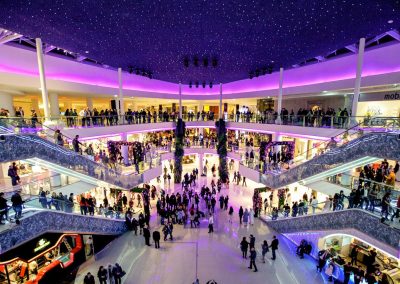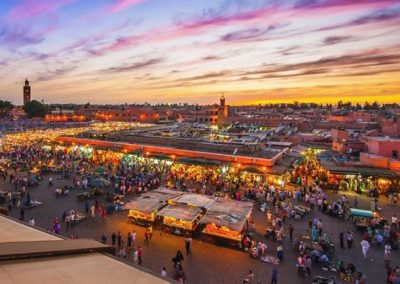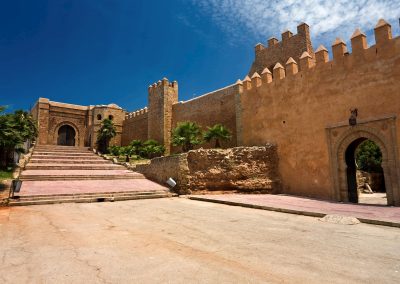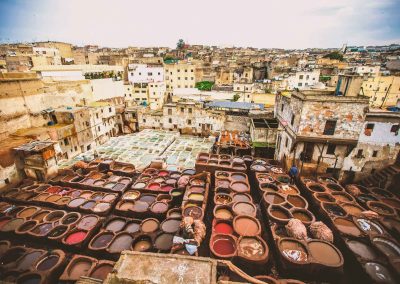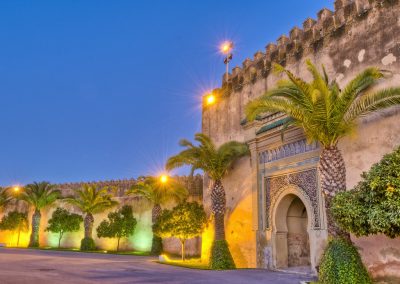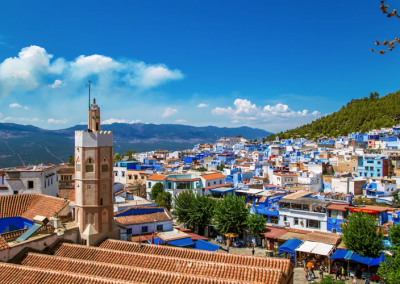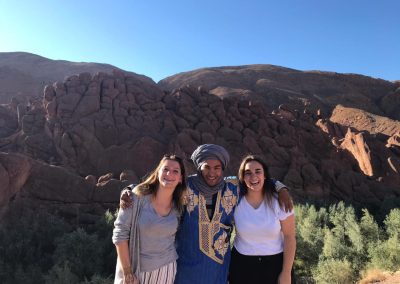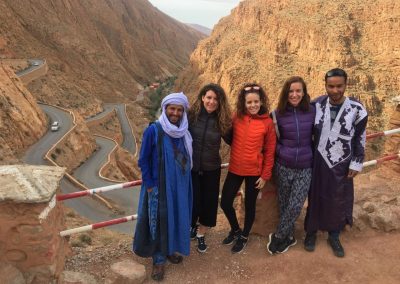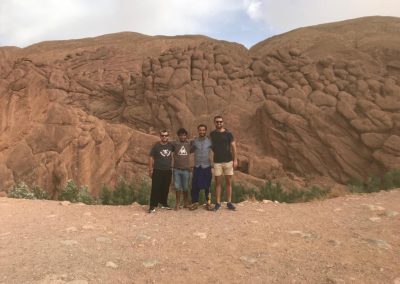5-Day Morocco Imperial Cities Tour from Tangier
Overview of our Morocco Imperial Cities Tour from Tangier
Embark on an enriching cultural tour from Tangier to Chefchaouen, delving into the heart of Morocco’s historical and scenic beauty. Begin your adventure with a drive through the Rif Mountains, pausing in Tetouan before reaching the blue-hued medina of Chefchaouen. Explore vibrant artisanal shops and enjoy rooftop dining with stunning views.
Journey onward to the Roman ruins of Volubilis, crossing through picturesque Rif villages. Continue to Meknes for a tour of its historical medina, including the famous Bab el Mansour and the Moulay Ismail shrine, before heading to Fes for an overnight stay.
In Fes, navigate through the oldest city’s narrow streets, starting with the Royal Palace gate and the historic Jewish quarter. Visit cultural and historical sites, including Al Qaraouine University, the Tanneries, the Attarine Museum, and the Moulay Idriss mausoleum. Enjoy lunch and explore various cooperatives before taking in a panoramic view of the entire Medina of Fes.
Discover the three distinct parts of Fes, then drive to Rabat and Casablanca, experiencing the rich history of Morocco’s capital and its largest city. Conclude your journey with a visit to the charming coastal town of Asilah before returning to Tangier. This cultural tour promises an unforgettable exploration of Morocco’s history, architecture, and hospitality.
Morocco Imperial Cities Tour from, Highlights
- Admire the scenic drive through the Rif Mountains and enjoy a pause in the city of Tetouan.
- Explore Chefchaouen’s blue-hued medina, influenced by Spanish architecture, with vibrant artisanal shops and charming rooftop restaurants and cafes.
- Visit the Roman ruins of Volubilis and delve into Moroccan history.
- Tour the historical medina of Meknes, including Bab el Mansour and the Moulay Ismail shrine.
- Navigate the narrow streets of Fes, visiting the Royal Palace gate, the Jewish quarter, Al Qaraouine University, the Tanneries, and the Attarine Museum.
- Discover the three parts of Fes: Fes el Bali, Fes-Jdid, and the Ville Nouvelle.
- Drive to Rabat and explore the capital city’s rich history.
- Conclude your journey in Casablanca, experiencing the blend of old and new in Morocco’s largest city.
- Stroll through Asilah, a charming coastal town with a Mediterranean influence.
- Spend nights in beautiful Riads and enjoy the warm hospitality of Morocco.
Details of the Morocco Imperial Cities Tour from Tangier
Day 1: Tangier to Chefchaouen
Our adventure begins with a scenic drive through the Rif Mountains, passing by the city of Tetouan. We will pause to appreciate the breathtaking landscape before reaching Chefchaouen. Known for its blue-hued medina influenced by Spanish architecture, Chefchaouen offers vibrant artisanal shops and charming rooftop restaurants and cafes. Spend your evening enjoying the cool breeze and stunning views from your Riad.
Day 2: Chefchaouen to Volubilis, Meknes, and Fes
After a delicious breakfast, we journey towards Volubilis, crossing through Ouazzane and other Rif villages. In Volubilis, explore the Roman ruins and delve into Moroccan history. We continue to Meknes for lunch and a tour of the medina’s historical walls, Bab el Mansour, and the Moulay Ismail shrine. In the late afternoon, we head to Fes for an overnight stay.
Day 3: Sightseeing in Fes
Today, we explore Morocco’s oldest city, Fes. Navigate through its narrow streets and alleys, starting with the Royal Palace gate and the historic Jewish quarter (the first Mellah in Morocco). Visit cultural and historical sites including Al Qaraouine University, the Tanneries, the Attarine Museum, and the Moulay Idriss mausoleum. After lunch, explore various cooperatives and enjoy a panoramic view of the entire Medina of Fes.
Day 4: Fes to Rabat and Casablanca
Discover the three distinct parts of Fes: Fes el Bali (a UNESCO World Heritage Site) with its 9000 narrow streets, Fes-Jdid (home to the Jewish quarter), and the Ville Nouvelle (created during the French occupation). Later, we drive to Rabat and then to Casablanca for an overnight stay.
Day 5: Casablanca to Asilah and Tangier
We depart from Casablanca to Asilah, a charming coastal town, and then continue to Tangier, where our tour concludes.
The price of this cultural tour depends on the number of travelers. Please fill out the booking form or contact us for pricing details.
what's included
- Spanish speaking driver
- Accommodations
- Transportation
- Breakfast and dinner
what's excluded
- Drinks
- Optional activities
- Personal expenses
About the 4 Morocco Imperial Cities
1. Marrakech – The Red City of the South
Marrakech, often referred to as the “Red City” due to its distinctive red sandstone architecture, is one of Morocco’s most iconic destinations and was founded in 1062 by the Almoravid dynasty. This vibrant city has served as an imperial capital multiple times throughout history and is renowned for its rich blend of Berber, Arab, and Andalusian influences. The medina of Marrakech, a UNESCO World Heritage Site, is a sensory overload of winding alleys, bustling souks, ornate palaces, and majestic mosques. One of the city’s most famous landmarks is the Jemaa el-Fnaa square, a lively gathering place filled with snake charmers, street food vendors, musicians, and storytellers, especially at night. Nearby, the Koutoubia Mosque dominates the skyline with its 12th-century minaret, while the Bahia Palace showcases intricate Moroccan architecture and garden courtyards. The Majorelle Garden, once owned by Yves Saint Laurent, offers a serene escape with its exotic plants and cobalt-blue buildings. Marrakech also serves as a gateway to the Atlas Mountains and the Sahara Desert, making it a central hub for adventure and culture. With its energetic ambiance and deep historical roots, Marrakech remains a must-visit city in Morocco’s imperial tapestry.
2. Fez – The Spiritual and Intellectual Heart of Morocco
Fez, also spelled Fès, is Morocco’s oldest imperial city and widely considered the cultural and spiritual capital of the country. Founded in the 9th century by Idris II, Fez has long been a center for Islamic learning, scholarship, and craftsmanship. Its ancient medina, Fes el-Bali, is a UNESCO World Heritage Site and one of the world’s largest car-free urban zones, preserving a labyrinth of narrow alleys, historic madrasas, vibrant souks, and medieval mosques. The University of Al Quaraouiyine, founded in 859, is recognized as the oldest existing university in the world, and still functions as a place of religious education. The Bou Inania Madrasa, with its exquisite zellij tilework and cedar wood carvings, reflects the city’s architectural brilliance. Fez is also famous for its traditional leather tanneries, especially the Chouara Tannery, where centuries-old methods are still used to dye leather in large colorful vats. Unlike the more tourist-oriented Marrakech, Fez offers a more authentic and introspective experience, immersing visitors in the rhythms of Moroccan daily life and centuries of uninterrupted history. It’s a city where time seems to stand still, making it a haven for history buffs and culture seekers.
3. Meknes – The Versailles of Morocco
Meknes, often overshadowed by its sister cities, is a hidden gem among Morocco’s Imperial Cities. Founded in the 11th century by the Almoravids, Meknes truly flourished in the 17th century under the rule of Sultan Moulay Ismail, who transformed it into a grand capital with ambitious architectural projects. Known as the “Versailles of Morocco,” Meknes boasts monumental gates, vast gardens, and impressive palaces. The city is surrounded by thick ramparts and features more than 20 gates, with Bab Mansour standing out as one of the most beautiful and intricately decorated gates in North Africa. The Royal Stables and Granaries of Heri es-Souani are massive structures that once housed thousands of horses and food supplies, reflecting Moulay Ismail’s vision of a powerful and self-sufficient capital. The Mausoleum of Moulay Ismail is one of the few sacred Islamic sites in Morocco open to non-Muslim visitors, and it provides a glimpse into the opulence of the Alaouite dynasty. Meknes is also located near the ancient Roman ruins of Volubilis, adding another layer of historical depth to the region. Less crowded and more laid-back than other imperial cities, Meknes offers a serene yet historically rich experience for travelers.
4. Rabat – The Modern Capital with Royal Legacy
Rabat, Morocco’s present-day capital, gracefully blends historic charm with modern elegance. Founded in the 12th century by the Almohad ruler Abd al-Mu’min as a military outpost, Rabat has evolved into a cosmopolitan city and administrative center while still preserving its imperial past. The city’s key landmarks reflect this dual identity. The Kasbah of the Udayas, perched above the Atlantic Ocean, offers panoramic views, charming blue-and-white streets, and a peaceful Andalusian garden. Nearby, the Hassan Tower, an unfinished minaret dating back to the 12th century, stands as a powerful symbol of the city’s ambitious past. Opposite the tower lies the Mausoleum of Mohammed V, where the tombs of the revered king and his sons are housed under a striking white structure topped with a green tiled roof. Rabat’s modern districts feature wide boulevards, embassies, museums, and well-manicured parks, making it one of the most organized and livable cities in Morocco. As both a royal and political hub, Rabat reflects the country’s forward-looking ambitions while honoring its deep-rooted heritage, making it an essential stop on any tour of Morocco’s imperial cities.
About Chefchaouen
Chefchaouen is one of Morocco’s most picturesque and unique destinations, often referred to as the “Blue City” due to its distinctive blue-painted buildings, which blanket the entire town in a mesmerizing hue. Nestled in the Rif Mountains of northern Morocco, Chefchaouen was founded in 1471 by the Almohad dynasty as a small military outpost. Over time, the city evolved into a vibrant cultural hub, attracting visitors from all over the world with its beauty, relaxed atmosphere, and historical charm. The most striking feature of Chefchaouen is the abundance of blue paint that covers the buildings, streets, and even some of the local businesses, creating an ethereal, almost dreamlike ambiance. The tradition of painting the city blue is believed to have originated from Jewish refugees in the 1930s, who thought the color symbolized the sky and the heavens, creating a calming and spiritual atmosphere. The city is a photographer’s paradise, with every corner offering a unique shot of cobbled streets, blooming flowers, and bright blue walls that contrast beautifully with the surrounding mountainous landscape.
In addition to its visual appeal, Chefchaouen offers a rich blend of Moroccan and Andalusian influences in its architecture, food, and culture. The town’s medina is a labyrinth of narrow, winding alleyways lined with quaint shops offering local handicrafts, from woven textiles to intricate jewelry and colorful pottery. Ras El Maa, a beautiful waterfall located just outside the city, is a popular spot for both locals and tourists, offering a tranquil escape where visitors can enjoy the serene surroundings and cool off in the crystal-clear waters. Chefchaouen is also known for its relaxed pace of life, which allows visitors to enjoy leisurely walks through its charming streets, visit the local markets, or relax at one of the many rooftop cafes that offer stunning views of the town and the surrounding mountains. For hiking enthusiasts, the nearby Rif Mountains provide ample opportunities for exploration, with trails leading to panoramic viewpoints and peaceful valleys.
While Chefchaouen’s fame is partly due to its visual beauty, it is also a place that evokes a deep sense of serenity and reflection, offering visitors a rare escape from the busyness of larger Moroccan cities. The town has managed to maintain its authenticity, and though tourism is growing, it remains a place where Moroccan culture, hospitality, and natural beauty converge harmoniously. Whether you’re seeking adventure in the mountains, a peaceful retreat in a vibrant, picturesque setting, or simply a chance to immerse yourself in local Moroccan life, Chefchaouen offers something truly special.
CUSTOMIZED ITINERARY
Need help designing travel plans tailored to your interests, travel dates and budget? Let our staff assist you in turning your dream vacation into reality!

